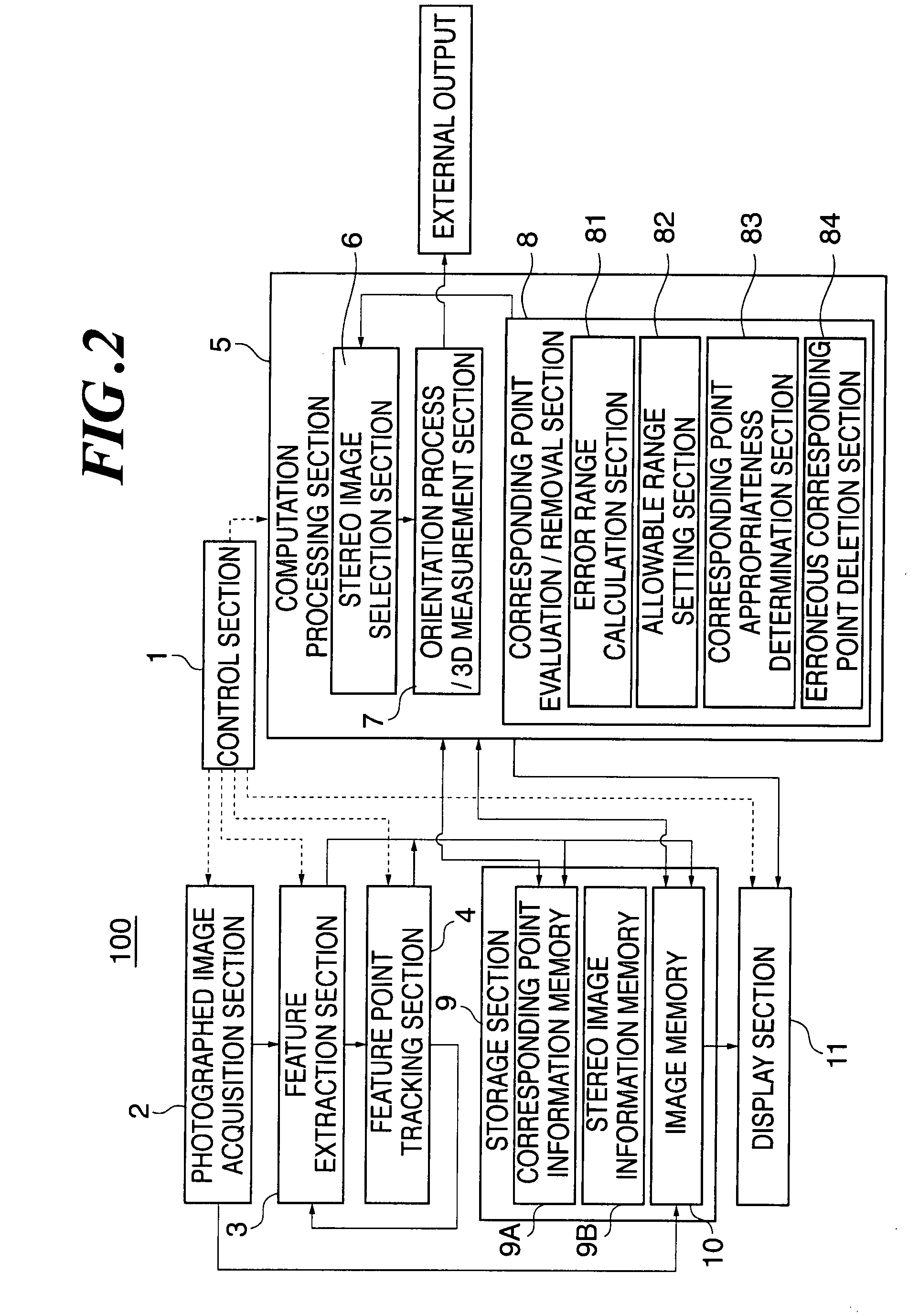Image processing device and method
a technology of image processing and image, applied in the field of image processing device and method, can solve the problems of deteriorating the measurement accuracy of 3d coordinates, difficult to perceive movement in a three-dimensional (3d) space, and sometimes being far from stable,
- Summary
- Abstract
- Description
- Claims
- Application Information
AI Technical Summary
Benefits of technology
Problems solved by technology
Method used
Image
Examples
first embodiment
[0067]FIG. 1 is a view for explaining the concept of this embodiment. In this example, a camera is mounted on a car to photograph the scene of a street as an object over time, or while gradually changing the position of the car, and the positional coordinates of the camera, or the tracks of the car, are obtained from the results of tracking using the plurality of photographed images. This technique enables car navigation systems to continuously display the position of the car, and more importantly complements such systems in areas where GPS radio waves cannot be received. In the embodiments described below, erroneous corresponding points in the photographed images, such as erroneously correlated feature points and feature points with movement or great sway, are removed as inappropriate for use to obtain the positional coordinates of the camera. In the first embodiment, the appropriateness of feature points is determined based on the presence or absence of overlap between the allowab...
second embodiment
[0130] In the first embodiment, the appropriateness of feature points is determined based on whether or not overlap between the allowable range and the error range exists. In the second embodiment, the appropriateness of feature points is determined based on whether or not the corresponding feature points exist inside the allowable range. That is, those corresponding feature points existing inside the allowable range are determined as appropriate, and those existing outside the allowable range as inappropriate. This embodiment is otherwise similar to the first embodiment.
[0131] According to this embodiment, in the example of FIG. 13, all the measurement points P11 to P13 are contained in the allowable range G, and thus preserved as allowable corresponding points. In the example of FIG. 14, with an overlapping range between the measurement points P11 and P12 set as the allowable range G, the measurement points P11 and P12 are contained in the allowable range G and thus preserved as ...
third embodiment
[0132] In the first embodiment, the appropriateness of feature points is determined based on whether or not overlap between the allowable range and the error range exists. In the third embodiment, the corresponding point appropriateness determination section 83 determines as inappropriate those corresponding feature points in the stereo images with the error range, for example obtained from the equations (8) and (9), exceeding a predetermined threshold. This embodiment is otherwise similar to the first embodiment.
[0133] According to this embodiment, a threshold may be set for the error range in the example of FIG. 12, so as to delete those corresponding feature points with the error range exceeding the threshold. For example, in the case where the error range E11 of the measurement point P11 exceeds the threshold, the corresponding feature point P11 is determined as inappropriate and excluded as an unallowable corresponding point. In this case, the allowable range setting section 8...
PUM
 Login to View More
Login to View More Abstract
Description
Claims
Application Information
 Login to View More
Login to View More - R&D
- Intellectual Property
- Life Sciences
- Materials
- Tech Scout
- Unparalleled Data Quality
- Higher Quality Content
- 60% Fewer Hallucinations
Browse by: Latest US Patents, China's latest patents, Technical Efficacy Thesaurus, Application Domain, Technology Topic, Popular Technical Reports.
© 2025 PatSnap. All rights reserved.Legal|Privacy policy|Modern Slavery Act Transparency Statement|Sitemap|About US| Contact US: help@patsnap.com



